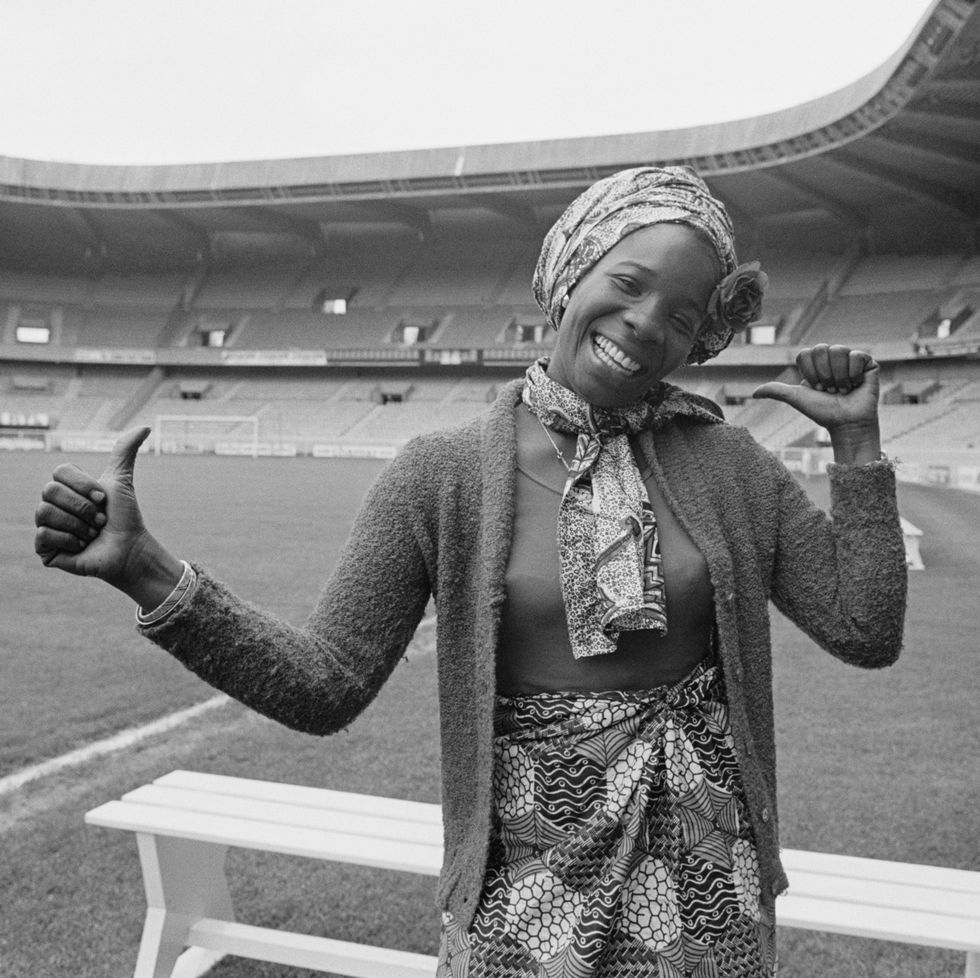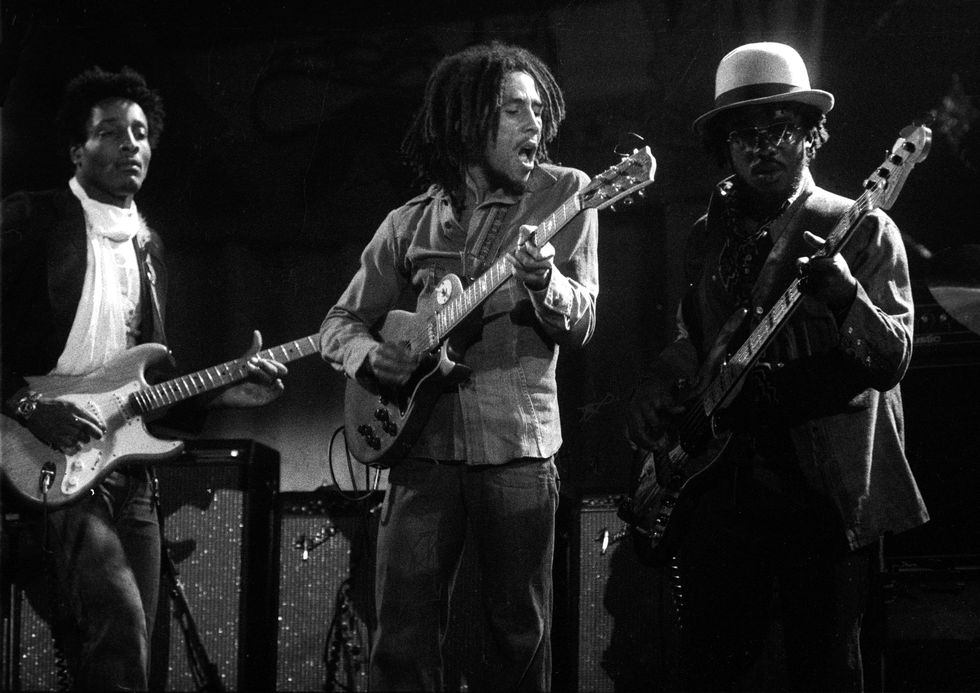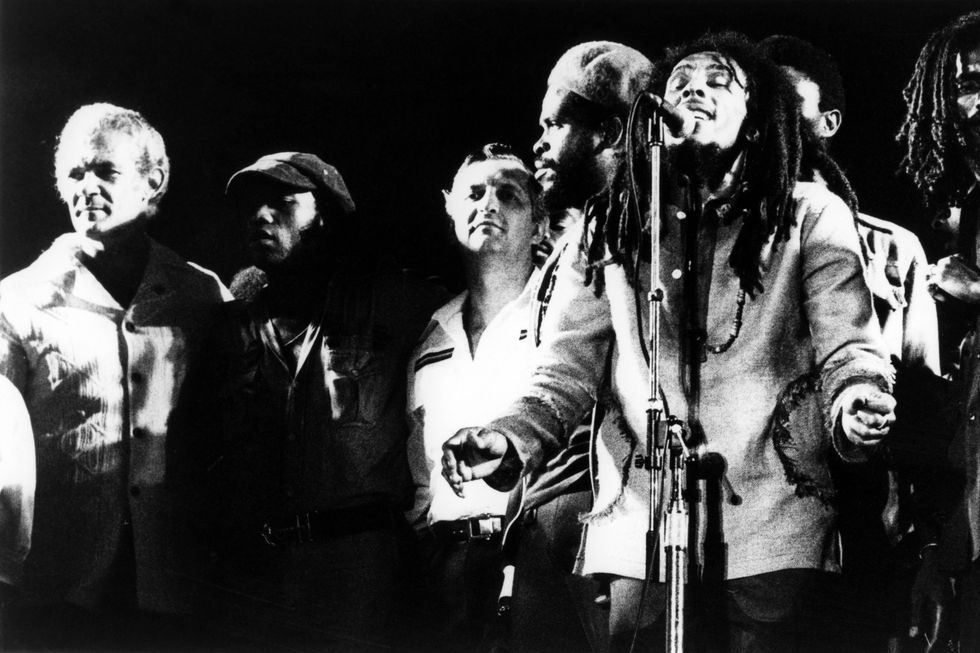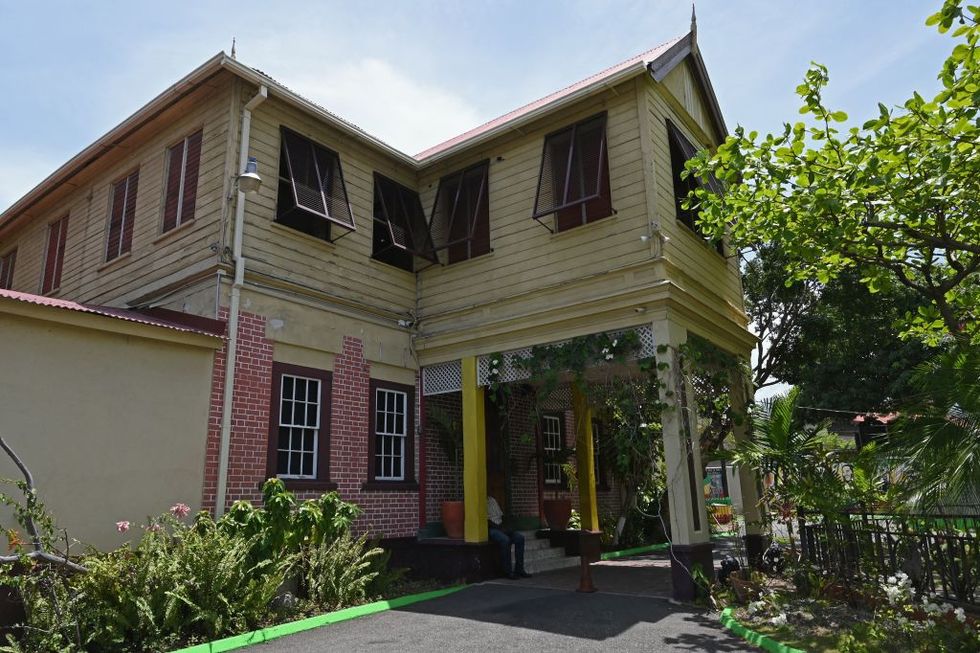1945-1981
Latest News: Late Singer Is the Subject of the New Biopic Bob Marley: One Love
Reggae icon Bob Marley is the latest musical great to receive a big-screen biopic, with actor Kingsley Ben-Adir portraying the late singer in Bob Marley: One Love. Despite his untimely death at age 36, Marley was hugely influential as a musician, popularizing reggae around the world, and as an advocate for peace. The movie, now in theaters, also stars Lashana Lynch as Marley’s wife, Rita.
Ben-Adir initially felt he wasn’t a fit for the role, as he couldn’t sing or dance. “My question was if [the casting personnel had] been on a worldwide search, and they said yes. And I said maybe they should go on another one,” he quipped to Entertainment Weekly. However, the actor learned to play guitar and sang all the songs during filming, though only some of his vocals were used.
Listen to a sampling of Ben-Adir’s vocals in the biopic’s trailer:
Who Was Bob Marley?
Jamaican singer-songwriter Bob Marley helped introduce reggae music to the world and remains one of the genre’s most beloved artists, having sold more than 75 million records. In 1963, Marley and his friends formed The Wailing Wailers, which eventually became Bob Marley & The Wailers. The Wailers’ big break came in 1972 when the band landed a contract with Island Records. Marley went on to sell more than 20 million records throughout his career, making him the first international superstar to emerge from the so-called developing world. A father to 11 children, Marley died from cancer in May 1981 at age 36.
Quick Facts
FULL NAME: Robert Nesta Marley
BORN: February 6, 1945
DIED: May 11, 1981
BIRTHPLACE: St. Ann Parish, Jamaica
SPOUSE: Rita Marley (1966-1981)
CHILDREN: Sharon, Cedella, Robert, Rohan, Karen, Stephanie, Julian, Ky-Mani, Ziggy, Damian, and Stephen
ASTROLOGICAL SIGN: Aquarius
Early Life
Robert Nesta Marley—better known as Bob Marley—was born on February 6, 1945, in St. Ann Parish, Jamaica.
Marley’s mother, Cedella Malcolm (later Cedella Booker), a native of Jamaica, was only 18 when she married a much older white man, Norval Sinclair Marley, who worked as a plantation supervisor. They separated shortly after Bob’s birth. Originally from East Sussex, England, Norval was largely absent from his son’s life, and Bob talked about him in scathing terms later on.
Bob spent his early years in St. Ann Parish, in the rural village known as Nine Miles. One of his childhood friends in St. Ann was Neville “Bunny” O’Riley Livingston. Attending the same school, the two shared a love of music. Bunny inspired Marley to learn to play the guitar. Later Livingston’s father and Marley’s mother became involved, and they all lived together for a time in Kingston, according to Christopher John Farley’s Before the Legend: The Rise of Bob Marley.
Arriving in the Jamaican capital in the late 1950s, Marley lived in Trench Town, one of the city’s poorest neighborhoods. He struggled in poverty, but he found inspiration in the music around him. Trench Town had a number of successful local performers and was considered the Motown of Jamaica. Sounds from the United States also drifted in over the radio and through jukeboxes. Marley liked such artists as Ray Charles, Elvis Presley, Fats Domino, and the Drifters.
Marley and Livingston devoted much of their time to music. Under the guidance of Joe Higgs, Marley worked on improving his singing abilities. He met another student of Higgs, Peter McIntosh (later Peter Tosh) who eventually played an important role in Marley’s career.
Music Career Beginnings
Local record producer Leslie Kong liked Marley’s vocals and had the teenager record a few singles, the first of which was “Judge Not,” released in 1962. Although he didn’t fare well as a solo artist, Marley found some success joining forces with his friends. In 1963, Marley, Livingston, and McIntosh formed The Wailing Wailers. Their first single, “Simmer Down,” went to the top of the Jamaican charts in January 1964. By this time, the group also included Junior Braithwaite, Beverly Kelso, and Cherry Smith.
The group became quite popular in Jamaica, but they had difficulty making it financially. Braithewaite, Kelso, and Smith left the group. The remaining members drifted apart for a time, and Marley went to the United States where his mother was living.
After eight months, Marley returned to Jamaica. He reunited with Livingston and McIntosh to form The Wailers. Around this time, Marley was exploring his spiritual side and developing a growing interest in the Rastafarian movement. Both religious and political, the Rastafarian movement began in Jamaica in 1930s and drew its beliefs from many sources, including Jamaican nationalist Marcus Garvey, the Bible’s Old Testament, and their African heritage and culture. It also considers the use of marijuana, known as the “holy herb,” sacred because the drug can produce heightened spiritual states. Marley smoked marijuana throughout his life and was an advocate for its legalization.
For a time in the late 1960s, Marley worked with pop singer Johnny Nash. Nash scored a worldwide hit with Marley’s song “Stir It Up.” The Wailers also worked with producer Lee Perry during this era; some of their successful songs together were “Trench Town Rock,” “Soul Rebel,” and “Four Hundred Years.”
Wife Rita Marley
Around the time of The Wailers’ hiatus in the mid-1960s, Marley married Alfarita “Rita” Anderson on February 10, 1966.
Rita, who was originally from Cuba but moved to Jamaica, sang in church growing up and joined a vocal group called The Soulettes as a teenager. She met Marley while in the group, and he coached her during this time. They continued collaborating professionally when Rita was a member of the I-Threes.
The couple shared five children and remained married until Bob’s death in 1981, despite his multiple extramarital affairs. Rita had trysts herself, and both had children with other partners during the marriage. “As they say you grunt and bear [the infidelity], that’s what I had to do because I was so in love with this man and love grew stronger, it’s not that it grew weaker,” she told BBC Caribbean.com in 2004.
As of July 2023, Rita is retired and lives in Miami.
Children
Marley’s estate has recognized 11 children belonging to the singer, including nine that he fathered and two he adopted.
With his wife, Marley had five kids. He adopted her daughters Sharon, born in 1964 before their marriage, and Stephanie, born in 1974 from one of Rita’s extramarital affairs. Together, the couple shared three biological children: daughter Cedella, born in 1967; son David, known as “Ziggy” Marley, born in 1968; and son Stephen, born in 1972.
Additionally, Marley had sons Robert (born in 1972), Rohan (1972), Julian (1975), Ky-Mani (1976), and Damian (1978), as well as daughter Karen (1973).
Many of Marley’s children followed his footsteps into the music industry. For years, Ziggy, Stephen, Cedella, and Sharon played together as Ziggy Marley & The Melody Makers. Ziggy and Stephen have also had their own solo careers. Sons Damian—known as “Jr. Gong”—Ky-Mani, and Julian are also talented recording artists. Other Marley children are involved in family-related businesses, including the Tuff Gong record label, founded by Marley in the mid-1960s.
Bob Marley & The Wailers
As he began having children, Marley continued his musical career. The Wailers added two new members in 1970: bassist Aston “Family Man” Barrett and his brother, drummer Carlton “Carlie” Barrett. The following year, Marley worked on a movie soundtrack in Sweden with Johnny Nash.
The band got its big break in 1972 when The Wailers landed a contract with Island Records, founded by Chris Blackwell. The group’s first full album under the new label was the critically acclaimed Catch a Fire from 1973. To support the record, The Wailers toured Britain and the United States in 1973, performing as an opening act for both Bruce Springsteen and Sly & the Family Stone. That same year, the group released their second full album, Burnin’, featuring the hit song “I Shot the Sheriff.” Rock legend Eric Clapton released a cover of the song in 1974, and it became a No. 1 hit in the United States.
Before releasing their next album, 1975’s Natty Dread, two of the three original Wailers left the group; McIntosh and Livingston decided to pursue solo careers as Peter Tosh and Bunny Wailer, respectively. Natty Dread reflected some of the political tensions in Jamaica between the People’s National Party and the Jamaica Labour Party. Violence sometimes erupted due to these conflicts. “Rebel Music (3 O’Clock Roadblock)” was inspired by Marley’s experience of being stopped by army members late one night prior to the 1972 national elections, and “Revolution” was interpreted by many as Marley’s endorsement for the PNP.
For their next tour, The Wailers performed with I-Threes, a female group whose members included Marcia Griffiths, Judy Mowatt, and Marley’s wife, Rita. Now called Bob Marley & The Wailers, the band toured extensively and helped increase reggae’s popularity abroad. In the United Kingdom in 1975, they scored their first Top 40 hit with “No Woman, No Cry.”
Already a much-admired star in his native Jamaica, Marley was on his way to becoming an international music icon. He made the American music charts with the album Rastaman Vibration in 1976. One track stands out as an expression of his devotion to his faith and his interest in political change: “War.” The song’s lyrics were taken from a speech by Haile Selassie, the 20th century Ethiopian emperor who is seen as a type of a spiritual leader in the Rastafarian movement. A battle cry for freedom from oppression, the song discusses a new Africa, one without the racial hierarchy enforced by colonial rule.
Shot in 1976
Back in Jamaica, Marley continued to be seen as a supporter of the People’s National Party. And his influence in his native land was seen as a threat to PNP’s rivals. This might have led to the assassination attempt on Marley in 1976.
A group of gunmen attacked Marley & The Wailers while they were rehearsing on the night of December 3, 1976, two days before a planned concert in Kingston’s National Heroes Park. Marley was shot, with one bullet striking his sternum and bicep. Another butllet hit Rita in the head. Fortunately, the Marleys weren’t severely injured, but manager Don Taylor wasn’t as lucky. Shot five times, Taylor needed surgery to save his life. Despite the attack and after much deliberation, Marley still played at the show. The motivation behind the attack was never uncovered, and Marley fled the country the day after the concert.
Later Albums and Songs
Now living in London, Marley went to work on Exodus, which was released in 1977. The title track draws an analogy between the biblical story of Moses and the Israelites leaving exile and his own situation. The song also discusses returning to Africa. The concept of Africans and descendants of Africans repatriating their homeland can be linked to the work of activist Marcus Garvey. Released as a single, “Exodus” was a hit in the United Kingdom, as were “Waiting in Vain” and “Jamming,” and the entire album stayed on the British charts for more than a year. Today, Exodus is considered to be one of the best albums ever made.
Marley had a health scare in 1977. He sought treatment that July for a toe he thought he injured earlier in the year. After discovering cancerous cells in his toe, doctors suggested amputation. Marley refused to have the surgery, however, because his religious beliefs prohibited amputation.
While working on Exodus, Bob Marley & The Wailers recorded songs that were later released on the album Kaya (1978). With love as its theme, the work featured two hits: “Satisfy My Soul” and “Is This Love.” Also in 1978, Marley returned to Jamaica to perform his One Love Peace Concert, where he got Prime Minister Michael Manley of the PNP and opposition leader Edward Seaga of the JLP to shake hands on stage.
That same year, Marley made his first trip to Africa. He visited Kenya and Ethiopia, an especially important nation to him as it’s viewed as the spiritual homeland of Rastafarians. Perhaps inspired by his travels, the band’s next album, Survival (1979), was seen as a call for both greater unity and an end to oppression on the African continent. In 1980, Bob Marley & The Wailers played an official independence ceremony for the new nation of Zimbabwe. Also that year, the United Nations awarded Marley its Medal of Peace.
A huge international success, Uprising (1980) featured “Could You Be Loved” and “Redemption Song.” Known for its poetic lyrics and social and political importance, the pared down, folk-sounding “Redemption Song” was an illustration of Marley’s talents as a songwriter. One line from the song reads: “Emancipate yourselves from mental slavery / none but ourselves can free our minds.”
On tour to support the album, Bob Marley & The Wailers traveled throughout Europe, playing in front of large crowds. They also planned a series of concerts in the United States, but the group only played three concerts there—two at Madison Square Garden in New York City and one performance at the Stanley Theater in Pittsburgh—before Marley became too sick to continue.
Death
Marley’s illness was a resurgence of the acral lentiginous melanoma discovered earlier in his toe. The cancer had now spread throughout his body, including his brain, lungs, and liver. Traveling to Europe, Marley underwent unconventional treatment in Germany and was subsequently able to fight off the cancer for months. However, it soon became clear that Marley didn’t have much longer to live.
The musician set out to return to his beloved Jamaica one last time to receive the Order of Merit from the Jamaican government. But, he didn’t manage to complete the journey. Marley died in Miami on May 11, 1981, at age 36.
Adored by the people of Jamaica, Marley was given a hero’s send-off. More than 30,000 people paid their respects to the musician during his memorial service, held at the National Arena in Kingston, Jamaica. Rita Marley, Marcia Griffiths, and Judy Mowatt sang, and The Wailers performed at the ceremony, too.
Marley’s death set off a legal battle over his estate, as he did not leave a will. According to Rolling Stone, his widow, Rita, was reportedly forced to sign a fake will in the late 1980s; the Jamaican government soon took control of the estate and sold it to the head of Island Records, Chris Blackwell. After a court battle, the family was granted possession in 1991.
Legacy: Museum, 2024 Movie, and More
In 1986, Marley’s widow, Rita, founded the Bob Marley Foundation, which works to “perpetuate the spiritual, cultural, social and musical ideals which guided and inspired [Bob Marley] during his lifetime.” She remains the organization’s chairperson. Rita also established the Bob Marley Museum at the site of the musician’s home in Kingston, Jamaica, from 1975 until his death. The museum has numerous personal items belonging to Marley on display and also features a theater, photo gallery, and record shop.
In 2001, Rita helped organize the rerelease of 18 of Marley’s albums. “The music is a salve that will heal the world eventually, so we thought that this generation that really didn’t get a chance to see Bob Marley and isn’t able to get some of his old selections will now be able to do this,” she said.
Marley has inspired multiple movies. The 2012 documentary Marley, directed by Oscar winner Kevin Macdonald, combined interviews with unheard tracks and footage of Marley to tell the story of his life and career.
On February 14, 2024, the biopic Bob Marley: One Love released in theaters with actor Kingsley Ben-Adir in the lead role. Members of the Marley family were involved in the movie’s production. Ben-Adir told CBS Sunday Morning he initially had misgivings about his fit for the role because of his stature. He is 6-foot-2, while Marley was 5-foot-6. Ben-Adir lost 40 pounds for his screen test. “It was too much. I felt sick, I wasn’t sleeping,” the actor said. “There were a lot of conversations with the family where it was like, ‘We’re just trying to find Bob’s essence and his spirit in this film. You can’t copy Bob.’” Ultimately, that helped him agree to job offer.
Decades after his death, Marley’s music remains widely acclaimed. Billboard reported in 2015 that Marley had sold more than 75 million records, including copies of albums released posthumously such as the multiplatinum greatest hits collection Legends. In January 2018, Blackwell sold the majority of his rights to Marley’s catalog to Primary Wave Music Publishing, known for its branding and marketing campaigns for “the icons and legends business.”
Quotes
- Emancipate yourselves from mental slavery / none but ourselves can free our minds.
- Open your eyes, look within. Are you satisfied with the life you’re living?
- One good thing about music, when it hits you, you feel no pain.
- In this bright future, you can’t forget your past.
- I want to give you some love, I want to give you some good good lovin’.
- I believe in freedom for everyone, not just the Black man.
- Herb is the unification of mankind.
- Every man got a right to decide his own destiny.
- Don’t worry about a thing / every little thing is gonna be all right.
- Better to die fighting for freedom than to be a prisoner all the days of your life.
- Don’t gain the world and lose your soul. Wisdom is better than silver or gold.
- Love the life you live. Live the life you love.
- The truth is, everyone is going to hurt you, you just got to find the ones worth suffering for.
Fact Check: We strive for accuracy and fairness. If you see something that doesn’t look right, contact us!
The Biography.com staff is a team of people-obsessed and news-hungry editors with decades of collective experience. We have worked as daily newspaper reporters, major national magazine editors, and as editors-in-chief of regional media publications. Among our ranks are book authors and award-winning journalists. Our staff also works with freelance writers, researchers, and other contributors to produce the smart, compelling profiles and articles you see on our site. To meet the team, visit our About Us page: https://www.biography.com/about/a43602329/about-us
Tyler Piccotti first joined the Biography.com staff as an Associate News Editor in February 2023, and before that worked almost eight years as a newspaper reporter and copy editor. He is a graduate of Syracuse University. When he's not writing and researching his next story, you can find him at the nearest amusement park, catching the latest movie, or cheering on his favorite sports teams.


















